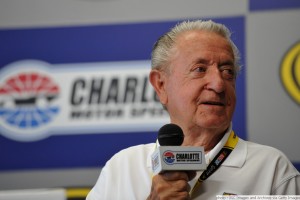This article is part of a series in advance of the 2015 NASCAR Hall of Fame Induction Ceremony in Charlotte, North Carolina, on January 30, to be broadcast live at 8 p.m. ET (9 p.m. AT) on NBC Sports Network, Motor Racing Network Radio and SiriusXM Satellite Radio. Bill Elliott, Fred Lorenzen, Wendell Scott, Joe Weatherly, and Rex White are the five 2015 inductees.
Over the years, NASCAR premier series champions have come in all shapes and sizes – tall, short, muscular and lean. The single constant? It’s impossible to judge a book by its cover.
Based upon first impressions, Rex White – at 5 feet 4 inches, weighing just 135 pounds and with his right leg withered by childhood polio – might have seemed the unlikeliest championship contender of all.
White, however, was tough as nails fearing neither competitor nor track conditions. He won the 1960 premier series title and posted 28 victories over five seasons, finishing among the top five in nearly half of his 233 starts.
“He looked more like a jockey than a race car driver,” fellow competitor Buddy Baker told the Gaston Gazette, “but he lived large once they started the race. On short tracks, he was very aggressive. He didn’t mind going in the turn with (NASCAR Hall of Famer and three-time premier series champion) Lee Petty and saying, ‘I’m inside and if you come down we’re not going to agree on stuff.’
“He raced hard.”
NASCAR Hall of Famer Bobby Allison, the 1983 premier series champion, said, “I admired Rex as a race driver because he was a little guy. I started out small. Seeing him winning encouraged me to chase my dream.”
What might have been a handicap to many only served as motivation to White, born Aug. 17, 1929 in Taylorsville, N.C.
“Most of the lessons I have learned (from childhood illness) have stayed with me all my life,” said White in his autobiography “Gold Thunder,” written with Dr. Anne B. Jones. “The biggest one was how to conquer fear.”
White learned to drive at age six, driving a neighbor’s truck in surrounding fields. Two years later he was working on his family’s Ford Model T. “I was unaware the car on which I labored represented hope to people around me (and) frustration to those trying to stop illegal moonshine,” said White. “I saw automobiles as transportation, not the symbol of an upcoming billion-dollar sport.”
White dropped out of school, moving to the Washington D.C., area where he found employment as a cook and, after marriage, a service station job. A poster advertising stock car races took White to Lanham (Maryland) Speedway where he caught on as an unpaid crew member for 1952 NASCAR Modified champion Frankie Schneider.
A year later, White returned to the track with a 1937 Ford purchased for $600 lettered “X.” He won his heat race, the semi-main and the feature. “I’d never won a trophy at anything,” said White.
White made his premier series debut in 1956 on Daytona’s beach/road course. In 1958, he teamed with crew chief Louis Clements in an “off the books” program by GM’s Chevrolet Division. They won twice in 1958 and five times the following year. The 1959 season also saw the debut of White’s iconic No. 4 gold and white Chevrolet.
The 1960 season was the first in which White ran a full schedule, going to the post only after he and Clement built a car for a competitor, the sale of which netted $2,000 for their own Chevrolet.
White won six times finishing 35 of 40 races among the top 10. White’s ninth-place finish at Birmingham, Alabama on Aug. 3 was his worst performance in the year’s final 15 races. The championship was a runaway, White beating NASCAR Hall of Famer Richard Petty by nearly 4,000 points.
“The thing about Rex is he thinks,” said Clements in a 1960 interview with Sports Illustrated. “When he’s out on the track, he’s planning and figuring out which cars he has to race to stay ahead.”
Car owner and engine builder Smokey Yunick, quoted in the same article, said, “Rex is not a cautious driver but he know when to use caution.”
White didn’t disagree. “I couldn’t run quite as fast as some of those other guys,” he said. “So long as I was smart and kept running; if any of those other guys had trouble, I had a chance.”
White nearly defended his title in 1961 winning seven times but finished second to NASCAR Hall of Famer Ned Jarrett. He added two more top-10 championship finishes before retiring at the conclusion of the 1964 season. Between 1959 and the 1963 seasons, White won more races than any other driver. He won 36 premier series poles – at least one in eight consecutive seasons – and finished second in NASCAR’s Short Track late model championship in 1959.
In retirement, White has owned an automobile dealership and for 25 years a trucking company, both in the Atlanta area where at age 85 he continues to reside. Named one of NASCAR’s 50 Greatest Drivers in 1998, White holds membership in the International Motorsports Hall of Fame, National Motorsports Press Association Hall of Fame and the Georgia Racing Hall of Fame.
- Rex White entered 233 NASCAR Cup races from 1956 through 1964, scoring 28 wins and the 1960 Cup championship.
- Rex White, 1960.
- Rex White, 1959.
- 1961: Rex White is shown at speed in his 1961 Chevrolet NASCAR Cup car during a race. White, the 1960 Cup champion, started 47 Cup events during the year, winning seven times, taking 38 top-10 finishes and second in Cup points.
- April 16, 1961: Driver Rex White (L) and his crew chief Lewis Clements (R) hold their trophies in victory lane at North Wilkesboro Speedway after White won the first Gwyn Staley Memorial NASCAR Cup race.
- Rex White, 2014.








